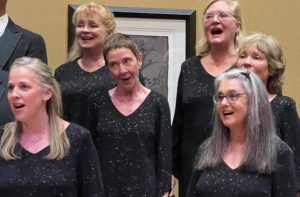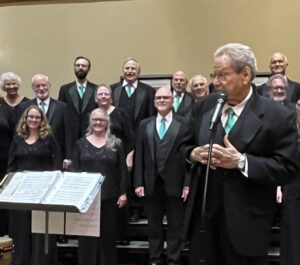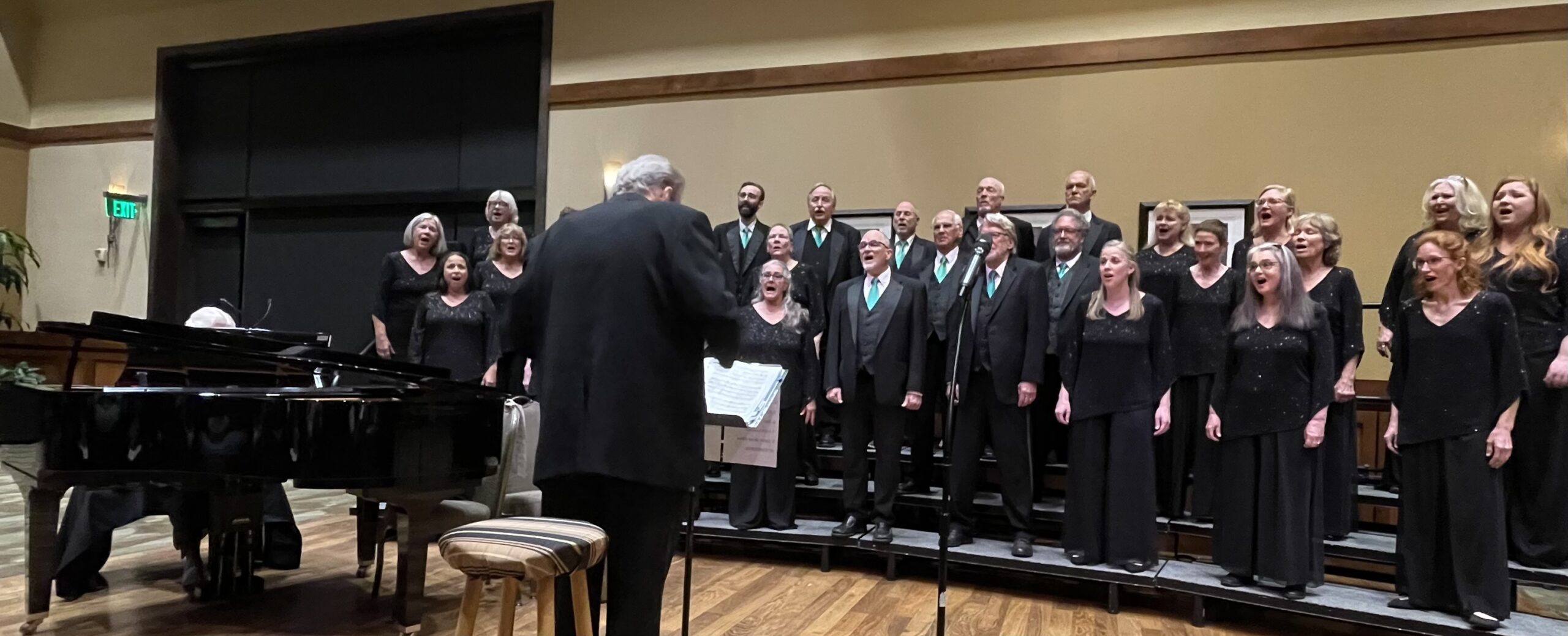This event was presented March 16 & 19, 2023.
So . . . in two recent concerts the Vocal Arts Ensemble managed to transport us to other countries as well as conjure the American spirit, almost all through folk tunes from more than half-a-dozen lands.
During its March 16 concert, the 30-voice choir, directed by the incomparable Gary Lamprecht and his more-than-able assistant conductor Melody Svennungsen, made magic with songs meant to move the audience and often evoke memories. It’s worth mentioning that when words and music weren’t familiar (such as the Ukrainian “Oy, Dub Duba”), the pieces clearly were chosen as excellent examples of their cultures, both entertaining and educational.
Lamprecht proved to be a most impressive tour guide, beginning the evening introducing himself as “kind of like Rick Steves,” the famous travel writer who encourages people to be discerning tourists interested in local ways of life. The comparison was more than apt.
 Members of the choir entered the Trilogy Monarch Dunes ballroom to the Japanese processional “Kokiriko Bushi,” accompanied by triangle and Kokiriko, a bamboo percussion instrument according to the concert program. These program notes, and the introductions to each song provided by the directors and members of the ensemble, make valuable contributions to audience enjoyment and are a welcome staple of Vocal Arts Ensemble concerts.
Members of the choir entered the Trilogy Monarch Dunes ballroom to the Japanese processional “Kokiriko Bushi,” accompanied by triangle and Kokiriko, a bamboo percussion instrument according to the concert program. These program notes, and the introductions to each song provided by the directors and members of the ensemble, make valuable contributions to audience enjoyment and are a welcome staple of Vocal Arts Ensemble concerts.
We were treated to sea shanties from New Zealand (“Soon May the Wellerman Come,” a bold tune evoking whalers on the high seas as the singers stamped their feet and sang of sugar and tea and rum) and from America (a rolling, unaccompanied “Shenandoah,” imbued with longing by the wholly engaged vocalists).
There were ballads, sung softly and sweetly: “Erev Shel Shoshanim” from Israel and “Danny Boy” from Ireland, so appropriate on the eve of St. Patrick’s Day (honored by bright green ties worn by members of the choir, adding a festive note to the performance).
The highlight of the “international” half of the concert, however, was a heartbreaking rendition of “Loch Lomond,” made even more haunting by an explanation of the lament’s origin, an educational experience for many in the audience who never thought about why there’s a difference between taking the high road and the low road. France was represented with a hearty “Aupres de Ma Blonde,” and Spain’s contribution was “Amor de mi Alma,” which was not quite a folk song, but still a moving love song. Judy Robertson’s accompaniment here and throughout the evening proved seamless and satisfying to the varied vocal requirements of the program.
 Closer to home, the second half of the program focused on traditional hymns and spirituals, filling the hall with the joyful sounds of “Will the Circle Be Unbroken,” “Over My Head,” and the “Battle of Jericho,” which the choir presented so enthusiastically that it was almost impossible not to sing and clap along. Warren Hamrick on banjo and Pat Lamprecht on tambourine accompanied an early 20th century “lively little piece” called “Ching-A Ring Chaw,” which was also accompanied by information about how such tunes were usually performed.
Closer to home, the second half of the program focused on traditional hymns and spirituals, filling the hall with the joyful sounds of “Will the Circle Be Unbroken,” “Over My Head,” and the “Battle of Jericho,” which the choir presented so enthusiastically that it was almost impossible not to sing and clap along. Warren Hamrick on banjo and Pat Lamprecht on tambourine accompanied an early 20th century “lively little piece” called “Ching-A Ring Chaw,” which was also accompanied by information about how such tunes were usually performed.
The audience was on its feet at the end of the program as printed, but then Lamprecht requested we remain standing, generously asking us to accompany the ensemble in a final sing-along to “Amazing Grace.”
This concert, just shy of an hour and a half long (with one intermission), left the audience wanting more. The second concert of the schedule, performed March 19 at the Cuesta College Cultural and Performing Arts Center (and not reviewed here), was a bit longer with the addition of four songs from the Central Coast Youth Chorus directed by Svennungsen.
In his director’s note, Lamprecht referenced the moment he felt the power of music for the first time when he sang in a public concert in fifth grade. “With that moment in mind,” he wrote, “we are happy to present our guest singers . . . We invite you to sit back and enjoy the moment that might affect a child as it affected me.”
Lamprecht’s hope, combined with the soaring voices and spirited volunteers who made these concerts possible, likely affected many a child present; but just as important, these concerts affected adults in attendance as well. Such entertainments are a shining example of why the Vocal Arts Ensemble and similar organizations who help children (and adults) access the arts deserve community support and funding.
